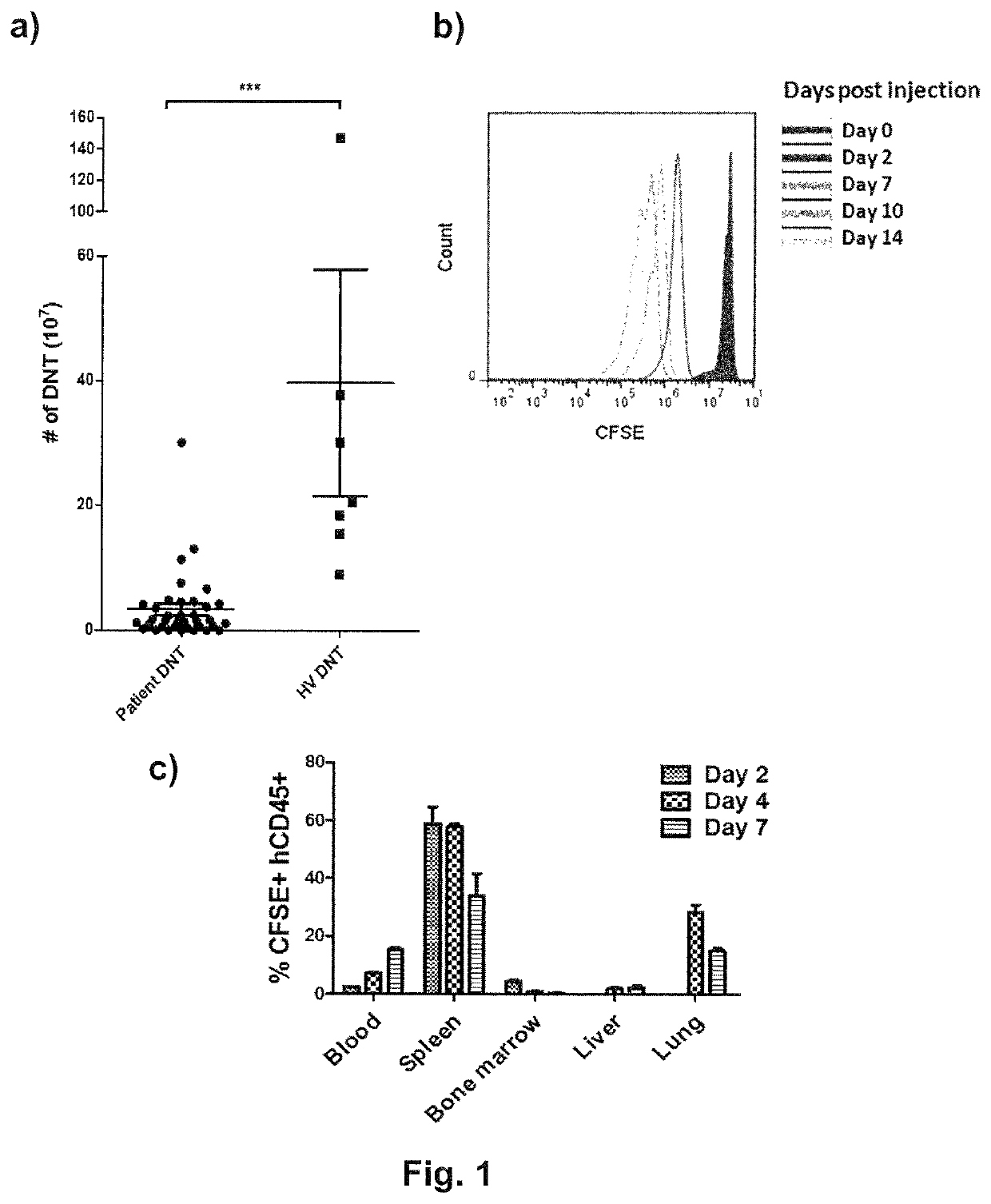Immunotherapy for the treatment of cancer
a cancer and immunotherapy technology, applied in the field of cancer treatment, can solve the problems of high relapse rate of aml patients
- Summary
- Abstract
- Description
- Claims
- Application Information
AI Technical Summary
Benefits of technology
Problems solved by technology
Method used
Image
Examples
example 1
Expansion of DNTs from Peripheral Blood of Healthy Donors
[0069]20 ml PB was obtained from HD or AML patients in complete remission after chemotherapy. DNTs were expanded as previously described (Merims et al., 2011). Briefly, CD4+ and CD8+ cells were depleted from peripheral blood mononuclear cells (PBMC) by using RosetteSep™. The remaining CD4− CD8− PBMC were stimulated with plate-bound anti-CD3 antibody for 3 days, washed, followed by re-stimulation with soluble CD3 from day 7 to day 10. Culture media was replaced with IL-2 containing fresh media on day 3, 7 and 10. Cells were counted and stained with anti-CD3, CD4, CD8, iNKT TCR (TCR Vα24-Jα18) antibodies and NKT receptor-antigen (α-Galactosylceramid) at the end of the 2 week expansion. Higher expansion potential of HD DNTs over patient DNTs were demonstrated in expansion cultures prepared with the equal volume of PB of AML patients in complete remission and HD, as significantly higher number of DNTs were obtained when expanded f...
example 2
Characterizing Human DNTs in a NSG Mouse Model
[0071]Successful adoptive T cell therapy relies on the survival and persistence of injected T cells in recipients so these cells can find and eliminate tumor cells. Ideally, the infused T cells are able to further multiply in recipients so that relatively small numbers of T cells will be needed for injection. Since DNTs are generated in a relatively short period (within 2 weeks of initial sample collection), these DNTs are likely early effectors and may proliferate and persist after injection. To test this hypothesis, an immunodeficient NSG mouse model was used. Day 10 ex vivo expanded DNTs were labeled with 5 μM CFSE and 2×107 cells were intravenously injected into sublethally irradiated NSG mice. In order to sustain human DNTs, recipient mice were supplemented with intraperitoneal injection of hrIL-2 (10,000 international unit (i.u.)). Blood, spleen, bone marrow, liver, and lung were harvested on day 2, day 4, and day 7 to determine th...
example 3
Development of a Flow-based Killing Assay
[0072]Chromium release assay has been the standard assay that is widely used to determine the level of cytotoxicity of target cells. However, due to a low chromium isotope loading efficiency and high rate spontaneous death of primary AML patient blasts, the widely used chromium-release assay was not optimal for determining the susceptibility of primary AML blasts to DNT-mediated cytotoxicity in vitro. In order to determine the ability of ex vivo expanded DNTs to induce cytotoxic activity against AML in vitro, a new flow cytometry-based killing assay was developed. In this assay, DNTs were labeled with fluorescent membrane dye, PKH-26, and co-cultured with primary AML-blasts for 2 hours at different effector to target ratios. Target and effector cells were cultured alone as controls to determine the level of spontaneous cell death. 2 hour post co-incubation, cells were stained with surface markers CD33 and CD45 antibody to identify AML that is...
PUM
| Property | Measurement | Unit |
|---|---|---|
| time | aaaaa | aaaaa |
| time | aaaaa | aaaaa |
| time | aaaaa | aaaaa |
Abstract
Description
Claims
Application Information
 Login to View More
Login to View More - R&D
- Intellectual Property
- Life Sciences
- Materials
- Tech Scout
- Unparalleled Data Quality
- Higher Quality Content
- 60% Fewer Hallucinations
Browse by: Latest US Patents, China's latest patents, Technical Efficacy Thesaurus, Application Domain, Technology Topic, Popular Technical Reports.
© 2025 PatSnap. All rights reserved.Legal|Privacy policy|Modern Slavery Act Transparency Statement|Sitemap|About US| Contact US: help@patsnap.com



